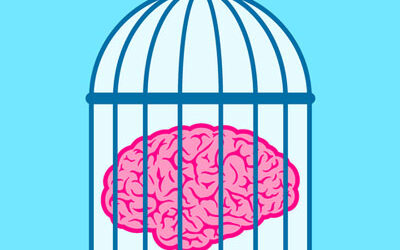
(continued from part 1) The ways ME/CFS and AIDS history are woven together in the US are just inextricable, so if Brea’s going to reference it, she has to get it right. Dr. Nancy Klimas touches upon this in Unrest, noting her early observations that ME/CFS patients shows an “acquired immune deficiency” similar to AIDS that involves dysfunction of natural killer cells. That can’t be a brief sound byte, without noting that in Japan, ME/CFS was for a long time considered a low natural killer cell syndrome, and then a US psychologist with heavy funding from the NIH (Fred Friedberg) became president of the largest international ME/CFS organization (the IACFS/ME, which had its conference one year in Japan), and began globally pushing rebranded ideas of dangerous cognitive behavioral therapy and graded exercise therapy (CBT/GET) approaches in scientific settings (Friedberg recently renamed these “fatigue self management“ or “FSM” as he tried to distance himself from the now-debunked PACE trials that so grossly harmed ME/CFS patients by forcing these approaches). These directed efforts to bury ME/CFS under erroneous psychobabble (in the US and other countries) have gone on for decades, abusively and lethally and branching far beyond retro notions of hysteria, so in terms of the spawning narratives around ME/CFS and how they morph into destructive ideas, its critical to be exacting.
If Brea also wants to weave in a feminist narrative (also talking about projected conversion disorders/hysteria in this day and age and the absurdity of that truth she personally faced), she must confront the inevitable reality that both Elaine DeFreitas and Judy Mikovits discovered evidence of an HIV-like retrovirus in ME/CFS before their careers were forcibly taken down by actual thugs (in the case of Mikovits, that man – Harvey Whittemore – who smeared her professional reputation and threw her in jail went to prison on unrelated federal charges). As a patient community, we also can’t ignore the way the great patriarch of immune-silencing, Anthony Fauci, was also once appointed by the government to spin the AIDS epidemic, and was in recent years appointed to rebrand ME/CFS (I haven’t read this book yet, but it’s further covered here), or how “virus hunter” Ian Lipkin – embroiled in a 2017 lawsuit accusing him of sex discrimination and of forcing his female colleague to examine lesions on his butt (I wish I were kidding, see: this) – received NIH grants for ME/CFS to hunt our central pathogen and look at our microbiome (yes, to look up our asses). With all of this going on in the context of high-profile sexual assault allegations and women demanding a bodily voice, it’s too trite and 2nd wave to reduce any feminist narrative within ME/CFS to “85 percent of patients are women” and an all-one mentality of cohesion. Two of my friends who took their lives in recent years, Patrick Kelly and Tom Hennessey, were male, and Tom was one of the last activists to have a national stage many years ago on Larry King Live, his voice loudly pealing about the links to AIDS, and the need to change the damn name. His voice was so refreshingly radical then; have things moved forward? Not really. There is still undeniable evil circling around ME/CFS. Another blogger made the point on Martin Luther King Jr. day that MLK Jr didn’t meet with leaders of the KKK because he wouldn’t humor an evil agenda or pretend it can be reasoned with, noting that ME activists meeting with the CDC – as Jen Brea recently did – is for patients a related version of humoring evil that gives perpetrators too much of a stage. With a solid history of how badly the NIH and CDC have treated ME/CFS patients, this argument of never humoring the enemy becomes pretty sound.
Around AIDS, gay men (and their allies) specifically revolutionized the role of visual language and aesthetics in AIDS activism at a time when 2nd wave feminism rapidly evolved because if people didn’t differentiate fragile identities and their differences within the “clusterfuck,” people died. So that’s where moments of Jen Brea’s muddling cause problems. She seems at times to identify with the lowest 25 percent of patients like me who are homebound and bedbound, but then she’s traveling to doctors in far-off cities, riding Dr. Klimas’ (Florida clinic) exercise bike to determine when she’s crossed a detrimental aerobic-anaerobic threshold, appearing in the desert with an RV, and seemingly at Stanford in Palo Alto then appearing at a Princeton reunion. The film gets way too clusterfucky by not explaining this well and without a clear chronology. This doesn’t imply she didn’t crash and really suffer for her efforts (which no profit from a film could make up for, really), but I for one have tried to get my denying family for decades to comprehend that I can’t travel, and they won’t believe it. They even repeatedly threatened to kidnap me to force me to “just move” and called me “intransigent” because of the effective geographic paralysis of severe ME/CFS, so I know any vague message around this does extreme damage to the sickest patients. Somewhere, Brea missed the point of the Robert Mapplethorpes and Keith Harings of AIDS art, how the sculptural curves of bodies disappear into chalk outlines in a flash if one isn’t meticulous with specifics. Let’s feature the images of people in darkened rooms, and Brea’s powerful use of Skype-interviews to reach far corners of ME/CFS isolation, but without cheapening that utopia by denying our critical differences. That visual language does matter, and desperately needs to be shifted under a sharp lens that pushes far beyond diarist-documentarian.
 So, I’m thinking of Heather because, as she was falling down the rabbit hole – losing friends, disbelieving family, financial resources – she kept writing queer celebrities to implore them to give her real help. As a queer-identified woman, she felt the only way to be noticed was to be a celebrity or be saved by one who had the power and connections to do something (“she was obsessed” said a mutual friend). I don’t think she was wrong that celebrity is access, access is power, funding allows dream-making, as Brea’s story and the success of Unrest ultimately proves, even as Brea deserves to tell her story. Heather’s story, though, was about trying to matter with too many strikes against her in the world. She could play instruments. She could write a searing line and her friends loved her to pieces. She could even crowd-fund more effectively than most. But her vocal pleas on the Internet couldn’t get her enough help.
So, I’m thinking of Heather because, as she was falling down the rabbit hole – losing friends, disbelieving family, financial resources – she kept writing queer celebrities to implore them to give her real help. As a queer-identified woman, she felt the only way to be noticed was to be a celebrity or be saved by one who had the power and connections to do something (“she was obsessed” said a mutual friend). I don’t think she was wrong that celebrity is access, access is power, funding allows dream-making, as Brea’s story and the success of Unrest ultimately proves, even as Brea deserves to tell her story. Heather’s story, though, was about trying to matter with too many strikes against her in the world. She could play instruments. She could write a searing line and her friends loved her to pieces. She could even crowd-fund more effectively than most. But her vocal pleas on the Internet couldn’t get her enough help.
And Heather’s story didn’t end with an inspiration narrative (the kind most in the disability community reject as ineffective and insulting), as Jen Brea’s did too much in Unrest. Heather became basically homeless, living temporarily in a hotel friends had raised money for, estranged from most family, increasingly bedbound and unable to care for herself, and then she chose to go that night to the train tracks, right there on the cusp of the right and wrong side of the tracks, where she’d been effectively driven by a lot of social forces – and end her own life. With invisible illness, shades of invisibility matter. Her story was not a mainstream, camera-ready narrative, even as she looked great on YouTube, begging earnestly for her life, saying heartbreakingly, “it’s the only life that I have.”
Unrest does depict the brilliant Ron Davis and his astonishing team that includes three Nobel laureates and still, as he notes in the film, his two applications to the NIH were returned without review (his wife Janet says about this, brutally, “I think we should tell them we’d like them to come around before our son is dead”). The conspiratorial level of government control (by forces like the NIH) to suppress this epidemic is so shocking with such understated punctuation I hope people can really hear it. But as my comfort level increased with the ups and downs (and triggering moments) watching Unrest, I suddenly saw my friend Patrick Kelly on the screen, his wispy-looking hair, giant smile, and artsy good looks. He was part of Brea’s montage of images of patients who had killed themselves, a deeply disturbing moment when some of the people were not described or even named (not even with an epitaph-like inscription), soon after the film talked about projections of hysteria on women. Then there was lovely Patrick, a straight white guy (with an artsy, funky, clever sense of what that meant) who cared about visual representation as a graphic designer, now flattened into a screenshot. Then I saw Vanessa Li – whose backstory I know chillingly though I didn’t know her personally – who took her life at age 32, just flashed there, her real and more nuanced story totally lost (when some of Vanessa’s specific story, featured nationally in The Atlantic, is easily quotable). At that moment, I couldn’t help but compare the offensiveness of depicting these lost-to-suicide ME/CFS patients to a YouTube celebrity (Logan Paul) who is now apologizing all around the Internet (but still profiting wildly) for showing dead bodies in Japan’s infamous “suicide forest.” It was tasteless, and disrespectful to the families and friends of tragically lost people who fought hard to keep going.
Beyond the “clusterfuck” of maligned patients dealing with multiple layers of loss, stigma, and oppression, Jen Brea’s film may broaden the medical canon of what this illness even is, and loosen the grip of social projections, and I truly hope it does – but it needs to be part of a much larger oeuvre of patient narratives and medical research and strong scientific reporting that stops arguing the same point of “not psychological” without going deeper into the specific history of that construction in ME/CFS. The distinctions in the clusterfuck illnesses matter tremendously if one is trying to shape a cultural narrative. For example, what about the study that found distinct spinal fluid markers in “CFS” versus primary Lyme patients, a newer study that found distinct brain markers in ME/CFS versus (similar) Gulf War Syndrome patients, but also, the distinctions between ME and the falsely constructed “CFS” shouldn’t confuse people (on why I’d ever use “ME/CFS” needs another post). Some of Brea’s distinguishing of ME/CFS as a mitochondrial disease are fitting, but her descriptions of ME/CFS’s most characteristic feature – post-exertional malaise or PEM – are way too oversimplified, when some of us crash for months or years to hellish, obliterating degrees. We can’t afford muddling at a time when the government’s thrown shade is still about pretending we’re symptomatically vague or factitious or (worse) concocting storylines from the Internet. Instead, we need to go forward reverse-clusterfucking right back at them with their meaningless words. The lens must be sharpened for that battle – and I hope, going forward, that it is. read part 1
*Heather had primary Lyme disease; Patrick, Vanessa, and Tom had primary ME/CFS, most had some indications of clusterfuck illness overlaps as well.









Thank you
I have just finished reading Part II. Again, brilliant analysis while shocking to learn what you had to experience in seeing your lovely friends flattened into anonymous screenshots and disrespectfully depicted without. Thank you, again, for writing this intelligent piece. A much needed critique to add some sobering sense, inside knowledge (to which Jen refused to listen when pwME tried to educate her by generously sharing their limited time and energy with her online) and thought to an incomprehensibly happy clappy public debate about this film.
My wife decided to die just after Vanessa Li. I laid across train tracks in 2013 while in a deep depression. I also had a gun in my mouth just five weeks before my wife died. I’m not as brave as my wife was. I have a lot more hope for treatment than I did in 2015.
I’m grateful I’m still alive. My wife asked me to continue to advocate for funding and treatment. Most importantly, she asked me to tell her story, which I do every chance I get.
Although you are right about some points, I am glad someone showed the world an inside peek in our world with ME.
And yes as a single I wonder too, what if I get bed ridden? Who will take care of me? Who will take care of my cats?
If you want to shine a light on all of our problems the documentary would be 10 hours instead of 1:30….. Despite some flaws I am glad the film is on Netflix. We are no longer invisible.
I constructed a comment, hit the wrong button and it was gone. The words and editing took my last drop. I can’t reconstruct it.
I feel like a bug on a giant highway after reading this piece. Thanks for the effort it took to compose such a fine analysis.
When I finished watching UNREST, I thought, is that all there is? But I am an old timer and I have too many stories to tell.
When the film ended, I thought, is that it? Yes, it is visually stunning in parts and in many ways, it is a love story, but the film did not speak for me or all the hundreds of people I have talked to over the decades.
I understand that the film had to be edited from years of filming. The story had to make sense. It is a story with a plot and characters. The editing had to be wrenching, dropping film clips off the computer. I recognize Jen and Omar’s journey and that ya can’t show that my journey is over 30 years.
SO I applaud and appreciate the incredible effort Jen devoted to making the film.
I am one who is fading like so many others. I know what the NIH did and I know what the CDC did to make hundreds of thousands of people invisible for 25 years.
I hope UNREST brings more funding, but I doubt it. The suits have listened to decades of testimony, real-life stories, over and over again. But those are words, not the visual.
I hope. I always hope because we have a new crop of people with CFS and ME. Doctors will not use ME in the US until the name is changed or goes back to the original ME from, what, 1957, Seward, Alaska?
Last of all thanks Peggy for all the effort it took to write your critique of the film. So many thoughts resonate with me, but I am too sick to write much at all.
Hey, Peggy, Have now read part two – seems Dr Friedberg is/was just another Wessely! I think on both sides of Atlantic we have been appallingly neglected by the medical and political establishments – I don’t know/understand every detail of what happened in USA but the general narrative of how pwME have been abused is fairly clear.
I have seen pwME saying that UNREST has changed how their friends/families perceive their illness and that has to be huge if you are struggling to be believed.
I agree that the chronology of Jennifer’s own narrative is a bit muddy, and I did not truly ‘feel’ the impact of what this illness had done to her, especially since at the end she is ‘grateful’ for the life lessons. I also find her to be inconsistent at times in what she says -outside of the film -and not particularly representative of many with ME. I wondered if she was more severely affected by POTS than ME as I watched.
But I still find the film to be a powerful tool for ‘beginners’ to the illness – especially through the other stories portrayed – (I go into this in greater detail in my own review).
Thank you again for what you have written – I hope your words are read by many who have seen the film, to give it a more robust context.
i decided not to watch the film. My gut instinct would be that it would being up too much pain that i can not deal with. I got his in college and lost a long term first love relationship due to the progression of the illness. I find that the losses of friends and also treatment by some family was heartbreaking on all levels. I have finally found a therapist in NYC after decades of looking. thats another thing impossible to find one who takes medicare or understands. this woman worked at mt sinai for 25 years treating severely brain damaged patients and accident victims- also people with mold damage to their brains- so she gets it. For me to finally after all these years have a place to lay out my pain and get it all out for an hour is a blessing. I have PTSD from what i have been through and so do many others. After reading what you wrote i feel i made the right decision in not seeing the movie now and i am also glad it is out there as others will learn from it and understand more. for me i think i undrsand way too much and that is why i take a pass.